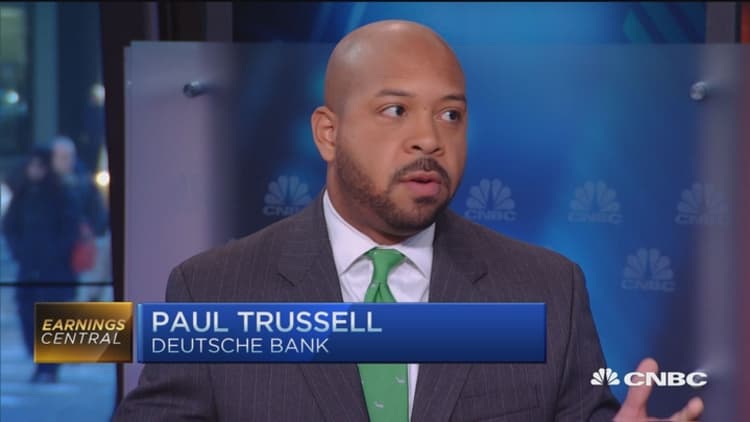
Investors knew the fiscal fourth quarter wasn't going to be blockbuster for Wal-Mart's profit.
However, many expected sales trends at the big-box retailer to come in stronger than the $129.7 billion it reported, given the multibillion-dollar investments it's pouring into its store associates, online capabilities and store fleet.
This 1.4 percent decline in revenue, which was capped off with a deceleration in its domestic same-store sales growth, sent Wal-Mart shares 4 percent lower Thursday, erasing much of the gains they'd logged this year.
While a strong dollar weighed significantly on Wal-Mart's revenue, analysts listed several other concerns about its domestic performance during the holiday period — namely, slower revenue growth at both existing stores and online.
What's more, just four months ago, the retailer outlined expectations for 3 to 4 percent sales growth over the next three years; yet already, it's lowered its projection for the current fiscal year to come in flat. (Excluding the impact of recent store closures and a stronger U.S. dollar, annual sales growth would have remained in the same 3 to 4 percent range.)
That's despite the fact that analysts had been looking at Wal-Mart as a potential beneficiary of incremental wage increases across the U.S., a prolonged period of low gas prices and its role as a safety stock given its shoppers' limited exposure to the gyrating stock market.
"The stock is down this morning given a lot of expectations and hope that Wal-Mart [U.S. comparable] sales would have improved more than the 0.6 percent, given the low gas prices and overall employment," Deutsche Bank analyst Paul Trussell told CNBC. "But Wal-Mart has been a market share loser now for a number of years. I think this is a very different backdrop than we had in 2008, when there was actual trade down and the economy was decelerating."
Wal-Mart's revenue of $129.7 billion for the fiscal fourth quarter was shy of Wall Street's expectations for more than $130 billion. The dollar played a big role in its performance, as revenues on a constant currency basis increased 2.2 percent, to $134.4 billion. Still, while the big-box retailer's U.S. comparable sales growth of 0.6 percent represented the sixth consecutive quarter of positive same-store sales, it was markedly slower than the 1.5 percent gain Wal-Mart logged in both the prior quarter, and the fiscal fourth quarter of the previous year.
The retailer also posted another slowdown in online revenue, recording a gain of 8 percent. That compares to a 10 percent increase in the third quarter, 16 percent growth in the second quarter, and a 17 percent boost during the first quarter. During the fourth quarter of the prior year, Wal-Mart's digital sales increased by 18 percent.
Stifel Nicolaus analyst David Schick told investors that although Wal-Mart refrained from offering free shipping during the holiday period — a tactic Target rolled out early in the season — it should nonetheless be accelerating digital growth given its investments in the space. After spending roughly $900 million on digital during the just-ended fiscal year, Wal-Mart expects to invest another $1.1 billion in e-commerce this year.
In a pre-recorded call with investors, Neil Ashe, Wal-Mart's head of global e-commerce, said the company saw "strong sales" on the big days from Thanksgiving to Cyber Monday. He added that more than half of the company's online sales on Thanksgiving were done on a mobile device, which was double that from the previous year.
Ashe also said the company saw a nearly 40 percent jump in store pickup during the holidays — a lift that was likely a result of it maintaining a $50 free shipping threshold.
Charlie O'Shea, lead retail analyst at Moody's, said it's important to remember that Wal-Mart's online business shouldn't be judged the same as those of Best Buy or Amazon, as more than half of its sales are derived from food. Consumers continue to push back against online shopping in that category, as the majority prefers to see consumables — particularly fresh foods — in person before they buy.
Overall, O'Shea said it's too early to judge Wal-Mart's progress in its transformation.
"We see long-term investments all the time take several quarters at least," he said, adding he expects to have a better read on the business in the second half of 2017. "It's a secular change in the industry and secular changes don't happen overnight."
Still, the company's results raised a caution flag among several analysts, who had pegged the retailer as a safety pick in 2016. Sentiment had risen surrounding the shares given their relative resilience to wild swings in the stock market, and stronger financials among low-income households. In particular, analysts had been anticipating wage gains among this demographic would encourage them to spend more in Wal-Mart stores.
But that story doesn't yet seem to be panning out. Craig Johnson, president of Customer Growth Partners, said continued weakness among low-income consumers is one reason why he expects sales growth among the overall industry to decelerate this year, which would be particularly troublesome for Wal-Mart.
"For the first time in its history ... they're expecting sales to be flat this year," Johnson said. "That's never happened."
Regardless of whether low-income consumers start spending more, Wal-Mart faces several other headwinds. Among them: A two-year, $2.7 billion investment in its store associates, deflationary food prices, a stronger U.S. dollar and tougher sales comparisons ahead.
"We are hopeful — but cautious — that Wal-Mart is an attractive defensive stock to own in the current mixed state of the consumer," Cowen analyst Oliver Chen told investors. "Cowen believes the higher-end consumer is weaker versus lower and moderate shoppers, and theoretically, Wal-Mart is positioned to benefit from this trend."
Update: This story has been updated to include additional information regarding the impact of foreign exchange and store closings.





